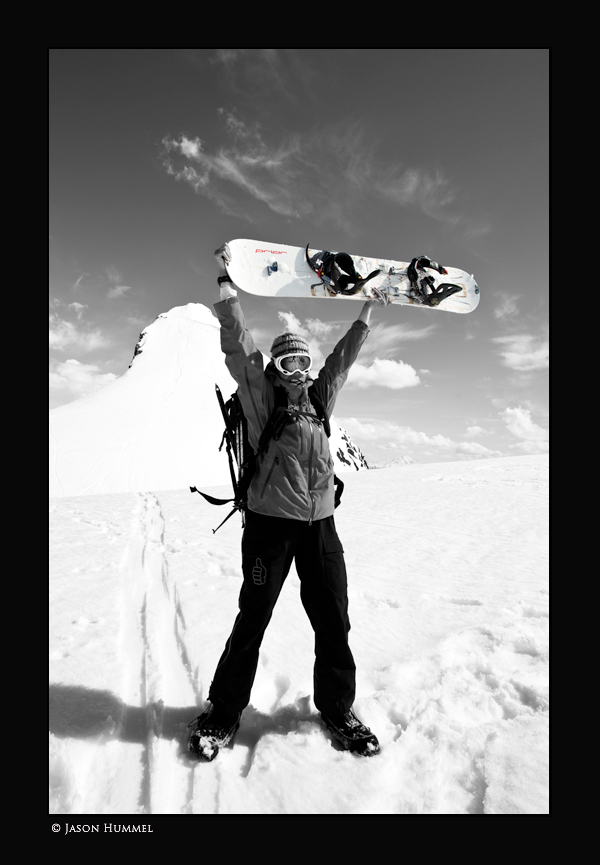Like many a splitboarder, I had spent years riding the standard Voilie slider plate setup. This was all fine and dandy until I got my hands on a pair of Spark R&D’s Fuse Bindings.
Since which bindings you choose for your splitboard setup is an important choice, and there really are a myriad of options out there these days, I wanted to really put the Fuses through the paces before delivering a solid review. From the waist-deep powder days to the bulletproof morning ice, I can say without a doubt that the Fuses performed above and beyond my expectations. I tested them on all types of snow and in all types of conditions, with well over 100 days and 300,000 vertical feet of riding.
Initial Impressions
At first glance, I noted the clean layout of the design. The smooth base integrates directly onto the board during downhill mode, and is attached with a single pin at the toe while skinning. I was really excited about being so close to the board while riding, before I even got on the binding, and this turned out to be an obvious improvement over the old Voilie design. Moreover, the graphics and overall look of the binding is sleek and sophisticated, something that never hurts.
How Does Riding Feel?
From the moment I put my boots into the bindings, I noticed a dramatic difference in the feel of the board. No longer separated from the board by pesky risers and their delayed reaction time, I felt an obvious increase in the measure of control I’d have over the board.
Riding yielded this result as well. Typically, I wasn’t overly stoked about the idea of having to ride resort to access a few backcountry lines, but suddenly things changed– I became inspired to take my split on resort laps, huck cornices, and air over crevasses. Previously pesky terrain features suddenly morphed into beguiling opportunities, and the playfulness that should characterize snowboarding returned to my splitboard.
How About Skinning?
Spark’s ads often quip, “You gotta get up, to get down.” So true when you’re backcountry, and as anyone who’s done a few days in the bc will tell you, you’re probably gonna spend about 90% of your time just accessing the goods. Enter Spark’s sleek pin design which puts the pivot point for your toe right next to the board (err…skis) just like, well, a telemark binding. Moreover, the simplicity of the layout allows for quick transitions with your gloves still on (great for those blower days when you find a bowl so nice you just gotta lap it up again and again).
I found that a huge advantage of this binding is the efficiency it provides when side-hilling. Steep slopes are suddenly easier to navigate because having the pivot point on the outside of the touring bracket (as opposed to on the inside, as on the Voilie system), allows for better edge control. It kind of became quickly apparent that these had been designed by a dedicated splitboarder…who was also an engineer.
I’d like to just preface this section by saying straight up: I’m really hard on gear. I think I’ve broken nearly every backpack I’ve owned, and even the burliest pants fall apart after 500 days of use. Nonetheless, wear and tear has worn these babies down over time and despite the fact that the Spark warranty department is stellar, I’ll just let you know how my pair of Sparks has worn down and what you can do to preempt any potential problems you could have with your own pair of these bindings.
- The bent metal buckle (that’s the strap-maker spark uses) can freeze up, so they take a little maintenance to get them to catch correctly on the strap ladders sometimes.
- After a lot of use, bolts connecting the highbacks can come undone. I recommend lock-tight to make sure those babies stay put; it’s done wonders for me.
- Sometimes a long day of skinning will leave a little bit of snow and ice buildup between the components at the base, forcing you to brush them clean before sliding the bindings onto the board in solid mode.
Miscellaneous Tidbits
A final thing I really love: gone are the days of searching all over my apartment for extra bolts and T-nuts that come loose and get lost in the snow with the slider plates. Those suckers are no longer needed with the spark design. Although having a power drill in my resort locker for binding switchovers along with extra goggles, gloves, gu, and gatorade was always humorous, it’s not a piece of equipment I’ll miss.
In summary….
Who: Spark R&D
What: The Fuse Bindings
When: Use whenever there is snow to slide on!
Where: On your splitboard, of course…
Why: Because these babies make it feel like you’re riding a solid board!
…and the price tag: $299 MSRP, and worth every penny!

